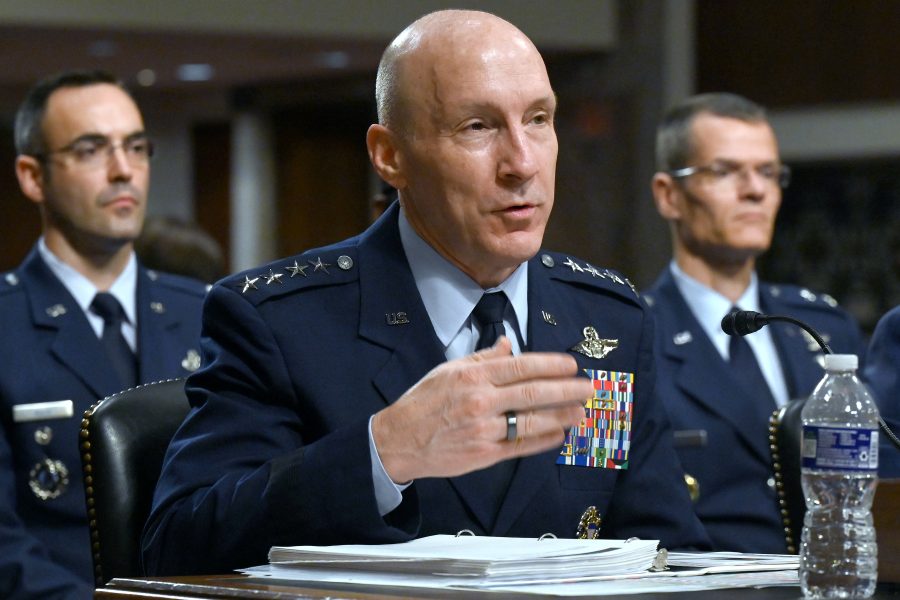The top Air Force officer says President Donald Trump’s ambitious “Golden Dome” homeland defense initiative could ultimately counter the kind of strike Ukraine carried out earlier this week, using drones to hit multiple Russian aircraft deep inside the country.
“I think the fascinating thing will be, to what extent, in the future . . . the Golden Dome will integrate not only [systems to counter] the larger ballistic, cruise, hypersonic missiles, but also some of these closer-in, more effective ones,” Air Force Chief of Staff Gen. David W. Allvin said at a June 3 Center for a New American Security event.
However, he said he believes the initial phase of Golden Dome development will not include closer-range defensive measures.
Kyiv launched a surprise attack using more than 100 drones, striking “34% of [Russia’s] strategic cruise missile carriers,” according to Ukrainian President Volodymyr Zelenskyy. Russia confirmed attacks in five regions including on multiple military bases.
“We’ll see how the conversation gets stirred up again based on the strike, but it shows us that seemingly impenetrable locations need to pay more attention to that,” Allvin added.
The Golden Dome project, which could cost $542 billion over the next two decades, is led by Vice Chief of Space Operations Gen. Michael A. Guetlein and is expected to rely heavily on satellites and other space-based technologies to detect and intercept incoming threats from drones to hypersonic missiles. Trump has set a goal to complete the project within three years, touting it as a way to “forever end the missile threat to the American homeland.”
But given the complexity of developing and fielding such technology, analysts view the tight timeline as ambitious. Guetlein has likened the mission’s scale to the “magnitude of the Manhattan Project,” warning that it will require a heavy lift from the Pentagon, intelligence agencies and various industries.
Allvin said Guetlein faces a daunting challenge and will require significant support. The Air Force is expected to play a key role, as the system relies on airborne defenses and close coordination with the Army and other services to ensure effective coverage, particularly in strategic regions like the Indo-Pacific.
The region’s defense posture is now in the spotlight as China looms as a threat that “could be imminent,” according to Secretary of Defense Pete Hegseth. While the impact of Ukrainian forces using small drones to strike Russia’s military bases and damage long-range bombers may not be a “wake-up moment,” it is certainly an “eyebrow-raising” one, Allvin said.
The Air Force is taking steps to make its critical assets in the Pacific more resilient in case of attack, like reinforcing aircraft shelters. As part of this effort, a seven-year project is underway at Andersen Air Force Base in Guam to upgrade the runway, hangars, and maintenance facilities to support both permanent and rotational forces, including allies’ fighter aircraft.
“It’s something that we haven’t necessarily been ignoring, but it’s been a matter of resource prioritization,” Allvin said. “We could really make it very defensive, but if all we’re doing is playing defense, and we can’t shoot back, then that’s not a good use of our money.”
As Washington starts to draw lessons on preventing a similar drone attack on American military assets, Allvin also suggested the Air Force should consider adding simpler aircraft that can make big impacts.
But he cautioned against the rising enthusiasm for inexpensive unmanned aircraft. Many believe the Air Force should invest in “a bunch of cheap, long-range, and kinetically powerful” drones, he said, but that’s a fantasy. Those three qualities don’t exist together, he argued.
Instead, Allvin stressed the need for a balanced force mix—using myriad cheaper aircraft to sow initial confusion before advanced platforms launch more critical attacks. A smart mix lets commanders apply “the right weapon for the right target,” and avoid having to “expend all your high-end kit” on every mission, he said.


